

Mound Builders is a solitaire board game designed by Ben Madison and Wes Erni for Victory Point Games. It puts you in charge of the mighty pre-Columbian North American city of Cahokia, which was located near modern day St. Louis, over a period of about 1500 years, covering what are now known as the Hopewell, Mississippian and Spanish Colonization eras.
I purchased the game a few months ago when, coincidentally, I had just finished reading
The People of The Morning Star" by W. Michael Gear
, so I was in a proper "Cahokian"
state of mind. The book is well researched fiction, but for anyone who may think this is not a proper historical period for a "war" game, just do a bit of
research on the periods covered by Mound Builders and you'll be amazed at how wrong you are. Ben and Wes did their research well and the game has got tons of
period "flavor".
I have not played any of the other Victory Point Games States of Siege series of games, so I did not approach the game with any preconceived notions or biases. Over the last few months, I've spent quite a bit of time playing Mound Builders and would like to relay my "lessons learned", share strategy tips and compare notes with other gamers. This article focuses on the first stage of the game, the Hopewell Era, and discusses the challenges of getting a good start (and the consequences of not getting a good start) in this interesting game.
This article assumes some level of familiarity with Mound Builders. If you're totally unfamiliar with the game, please see Marco Arnaudo's video review for an excellent introduction.

During the Hopewell Era, there is very little friction with the game system, other than the occasional Revolt which is a minor setback at this stage of the game. Most of this initial era should be spent expanding your empire and extending your influence over surrounding Chiefdoms that exist along five separate Warpaths, which represent the major competing tribes of the period (Ho-Chunk, Shawnee, Cherokee, Natchez and Caddo)
This early expansion does not represent military conquest or aggressive acquisition, but rather an extension of influence due to the attractiveness of Cahokian culture and also the spread of the Cahokian religious beliefs (see 'The People of the Morning Star', mentioned above). Accordingly, the process is called Discovery. Although the Hopewell Era is a low intensity period, in my opinion the game is won or lost during this Era. If you cannot establish a solid, defensible presence along all of the neighboring Warpaths during Hopewell, your position will deteriorate rapidly during the chaos of the Mississippian Era... and it will be an early night.
When evaluating a new game, particularly a solitaire game, I normally attempt to break it down into a series of quantifiable tasks or objectives. Then I determine what constitutes success or failure for each task/objective, outline several possible courses of action for each, and establish probabilities of success for each course of action. There are a lot of variables, which notches up the replay value considerably. Don't be fooled by the compact size of the game; there's a lot going on. The rules are not trivial and the strategies can get pretty deep. You have to understand all the rules interactions before you can have a shot of beating the system. Be prepared to get your butt kicked on the first few tries.
There are some general things you should be aware of before you begin the Hopewell Era:
Each Hopewell Era History Card has an Action Point value from 1 to 4. The Action Points are the basic currency of the game. The more Action Points you have, the more you can accomplish during the Era. The table below breaks down the Action Point value of the Hopewell Era history cards.
| Action Point Value | # of Cards |
|---|---|
| 1 AP | 1 Card |
| 2 APs | 3 Cards |
| 3 APs | 4 Cards |
| 4 APs | 4 Cards |
| Max Action Points | Min Action Points |
|---|---|
| 32 | 27 |

There are 12 Hopewell Era cards, but the game's basic rules direct you to randomly pick 10 of them and to discard 2. Given the distribution of Action Points across the Era's cards, you will have a total of 27 to 32 Action Points for the entire Hopewell Era. So you have to plan to accomplish all your Hopewell objectives with the worst case scenario of 27 Action Points.
While the Action Points due to initial card draw are an important factor in the early game, in my experience thus far a more important early determinant of success or failure involves another "luck of the draw"; the initial Chiefdom placements.
During initial setup, you must draw an unmounded Chiefdom for each of the 5 Warpaths: Ho-Chunk, Shawnee, Cherokee, Natchez and Caddo. These Chiefdoms are placed on Land #1 for each Warpath (i.e. the first space immediately outside Cahokia). Each unmounded Chiefdom has a Battle Value value from 2 to 4. In order to Incorporate these initial Chiefdoms into your empire, and place a Peace Pipe on its Warpath, you must roll a number higher than the Chiefdom's Battle Value (on a 6-sided die).
If you have the misfortune to draw all 4-point (Battle Value) Chiefdoms to initially surround Cahokia, your odds of winning drop dramatically. Note that the breakdown of 2-, 3- and 4-point Chiefdoms is pretty even, so you should not often find yourself with five 4-point Chiefdoms surrounding Cahokia... but it has happened to me.
| Battle Value | # of Chiefdoms |
|---|---|
| 2 point | 8 Chiefdoms |
| 3 point | 9 Chiefdoms |
| 4 point | 8 Chiefdoms |
With only a 33% chance of successfully Incorporating a 4-point Chiefdom (need a roll of 5 or 6), you'll waste too many Action Points in failed rolls, leaving you unable to expand and reinforce your empire in sufficient measure to survive the pressure of the Mississippian Era. Fortunately, there are ways to ameliorate the bad effects of a difficult initial Chiefdom draw:
So my first strategy is to be a total wimp and force yourself off to a good start. I know that the proper thing to do when initially drawing a powerful set of Chiefdoms surrounding Cahokia would be to just soldier on, and find a way to win anyway. But the later stages of the game are so much more fun, I just wanted to tip the balance in my favor, making it more likely that I'd actually survive to see the Spanish Era. So, use these options if you need to.
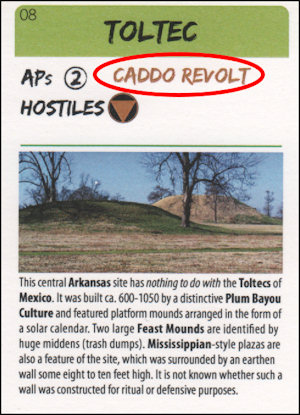
| Tribe | # of Revolt Cards |
|---|---|
| Caddo | 3 Cards |
| Cherokee | 2 Cards |
| Ho-Chunk | 3 Cards |
| Natchez | 2 Cards |
| Shawnee | 2 Cards |
As mentioned earlier, the Hopewell Era is really not a time of open conflict, but Revolts can set you back quite a bit if the dice don't go your way. Every one of the Hopewell Era history cards shows the name of the Tribe that will Revolt that turn. You don't have a lot of control over which Tribe will Revolt since you're picking cards randomly, but you can play the odds to achieve the best possible outcome.
As you can see from the table, the Ho-Chunk and Caddo are the most likely to Revolt, so I recommend that you not extend your control too far along those Warpaths, as you're likely to have at least two Revolts on each, with at least one or two resulting in a setback (in this case, a Peace Pipe retreat/loss). So, all other things being equal, extend your control along the Cherokee, Natchez and Shawnee Warpaths instead.
| Warpath/Tribe | # of Ascension (+1) Cards | # of Decline (-1) Cards |
|---|---|---|
| Caddo | 0 | 5 |
| Cherokee | 0 | 1 |
| Ho-Chunk | 3 | 0 |
| Natchez | 0 | 1 |
| Shawnee | 0 | 2 |
Each Hopewell Era history card contains one Warpath Scouting indicator that shows the current state of the Chiefdoms (and later, Armies) along a Warpath. It may indicate that they are either in Ascension (+1) or Decline (-1). If in Ascension, it will be more difficult to operate against the Tribe; if in Decline, it will be easier. For purposes of the Hopewell Era, specifically, it means that Battle Value of independent Chiefdoms you are trying to incorporate will either be increased by +1 (making it harder for you to incorporate) or decreased by -1 (making it easier for you to incorporate).
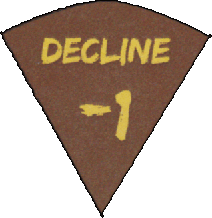
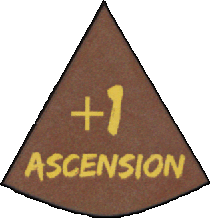
The table shows a serious disparity in Ascension/Decline ratios between the different Tribes. It seems that the Caddo will often be at a disadvantage (0 Ascensions and 5 Declines!), while the Ho-Chunk are more likely to hold the advantage (3 Ascensions and 0 Declines). But it's really the Cherokee and Natchez that attracted my attention, because they only have 1 Decline each. I highly recommend that when their Decline card is pulled, you take advantage of it to attempt an Incorporation of a Chiefdom on their Warpath, or Mound a Chiefdom for reduced cost (more about Mounding later).

| Warpath/Tribe | # of Hostile Advances |
|---|---|
| Caddo | 14 |
| Cherokee | 22 |
| Ho-Chunk | 14 * |
| Natchez | 19 |
| Shawnee | 18 * |
Because the Hopewell Era is all about preparation for the subsequent eras, we must anticipate future problems and take steps to avoid them, or at least reduce the impact. One of the key activities during the Mississippian Era is the advance of enemy Armies down their Warpath, heading straight for Cahokia! Therfore, when determining how strong to make the defenses on each Warpath, and how much treasure to spend to reinforce them, the anticipated ferocity of the enemy armies should be taken into account. Each history card in the post-Hopewell Eras contains one or more Hostile Advance orders that will direct you to make an advance of 1 or 2 Lands (spaces) with one or more Armies. Knowing the distribution of these advances helps in defensive planning.
* = Assumes that you survive to play 'The Spanish' card twice. Also note that these numbers are an approximation since a variable number of cards (4 on average) per game will not actually get played. Thanks to Wes Erni for the correction.
The distribution shows that the Cherokee will be advancing along their Warpath towards Cahokia at a much more aggressive pace than all the other Tribes, particularly the Caddo and the Ho-Chunk. What these statistics tell us is that we had best be prepared to repel repeated and persistent attacks along the Cherokee Warpath, right from the start of the Mississippian Era. That means "discovering" more Chiefdoms along the Cherokee Warpath than on the others, and Mounding more than one Chiefdom on the Cherokee Warpath if possible, because un-Mounded (or Plain) Chiefdoms have no intrinsic defensive capability.
If you can "discover" three or four of the five Cherokee non-Homeland Lands, Mound two of them, and retain your Peace Pipe on the Warpath, that will leave you in pretty good shape for the Cherokee onslaught.
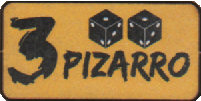
| Warpath/Tribe | Chance of Spanish Appearance |
|---|---|
| Caddo | 16.67% |
| Cherokee | 50.00% |
| Ho-Chunk | 0.00% |
| Natchez | 33.34% |
| Shawnee | 0.00% |
Wow! Considering how important an event the arrival of Spanish is, the 50% chance of arrival on the Cherokee Warpath is a gigantic red flag. I did not find anything in the rulebook or Designer's Notes that mentioned the logic behind the lop-sided odds. I can make a pretty good guess that, because the Cherokee Homeland (in the game) exists smack in the middle of Florida, and the Spanish historically first landed in America in that vicinity, the designers decided to keep that bit of historical accuracy rather than totally randomizing it. And my guess is that the possibility of Spanish arrival from the south (Natchez) or west (Caddo) was included to add some uncertainty.
The liklihood of Spanish arrival on the Cherokee Warpath, combined with the natural aggressiveness of the Cherokee Tribe itself (as evidenced in Tip #4, above) now makes the defense of the Cherokee Warpath priority #1. You can possibly afford to give up a little ground on the other Warpaths, but the line must be drawn, and maintained, on the Cherokee Warpath. During later Eras, you must aggressively counterattack to retain control of the Warpath. But for the more peaceful Hopewell Era, extend your control out as far as possible, Mound more than one Chiefdom, and make sure that Peace Pipe remains in place.
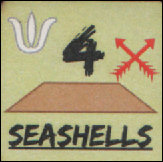
Each Chiefdom has a Trade Good Type listed on it. This represents the type of goods produced and traded by that Chiefdom. Starting with the Mississippian Era, the distinct number of Trade Goods present in all Chiefdoms will determine your current Trade Goods level, which often determines how many Action Points you get for the turn. In order to get a Trade Good point for a particular Trade Good Type, you must have either 1) two Plain (un-Mounded) Chiefdoms of that Trade Good Type or 2) one Mounded Chiefdom of that Trade Good Type.
There are two Trade Good Types, Obsidian, and Seashells that are rare and appear on only one Chiefdom. So if you want to get Trade Good points for these two types, make sure that you Mound the Obsidian and Seashells Chiefdoms. As mentioned earlier, you can wait until the Mississippian Era to Mound these but it's best to get it done during the Hopewell Era so you can begin collecting Trade Good points for it immediately at the start of the Mississippian Era.
As with so many other things in this game, you must weigh the benefit of Mounding these Chiefdoms against other competing interests and priorities (some of which are mentioned above).
You can use the following list as a general rule of thumb when trying to determine which Chiefdom to "Mound" next:
A lot of information has been presented in this article and it's all good information on its own. But you have to think a bit deeper in order to play Mound Builders well. You have to start looking for the relationships between the various statistics. For example, let's say you're considering which Chiefdom to Mound. You have not yet Mounded the Chiefdom that produces Seashells, which is priority #1 on the "Mounding Priorities" list. But it's located on the Caddo Warpath, and the Caddo are, by far, the most likely to suffer a Decline (-1) so maybe you should wait until one of those Decline cards is drawn. And how far out on the Caddo Warpath is the Chiefdom? If it's close to the enemy Tribal Homeland, it will come under attack almost immediately at the start of the Mississippi Era and you're down to your last few cards, so you really can't delay in Mounding it. And so on...

There are many other aspects of the game that I have not even touched on yet and the strategies compound when you get into the Mississippian and Spanish Eras. So I'm sure I'll be enjoying Mound Builders for some time to come. I'm wrestling now with constructing a set of rules for Mississippian Era action, such as rules to determine when it's best to defend a Mounded Chiefdom versus ignoring an advancing enemy army; when it's best to counter-attack versus rebuilding a Warpath's Peace Pipe. And other such dilemmas.
You know how people have games, usually computer games, that they play every spare minute they have? Games like Windows Solitaire that folks will play for five minutes here and there, just to take a mental break from work and decompress? Like meditation, almost? Well, Mound Builders has become my "decompression" game. I have it set up on a corner of my game table, and I just can't walk by it without stopping to play a card or two. I'm on the hunt for the perfect strategy...
I highly recommend Mound Builders and would like to congratulate Ben Madison and Wes Erni for creating such an interesting and enjoyably playable deisgn.